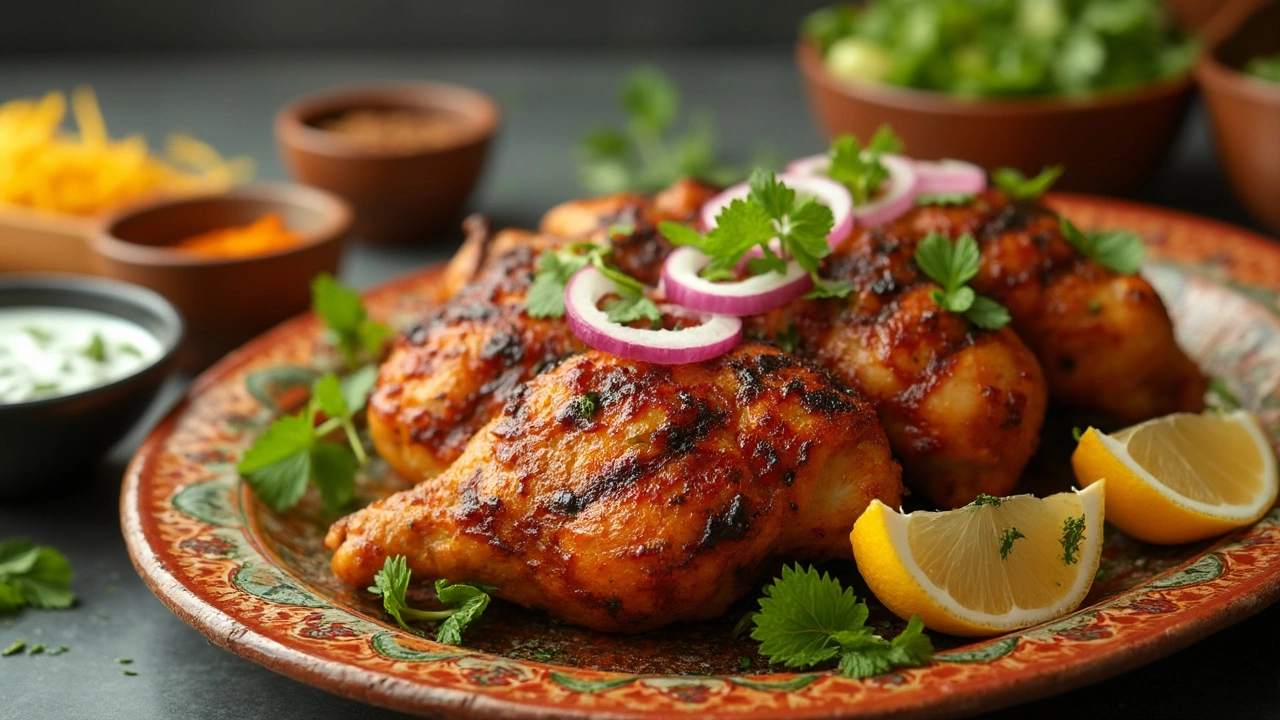Tandoori chicken might be the star at every Indian BBQ, but is it actually gentle on your stomach? A lot of people assume spicy food means trouble for digestion, but the story isn’t that simple. Tandoori chicken isn’t deep-fried, and it skips heavy sauces found in butter chicken or korma. Instead, it’s all about yogurt, spices, and that hit from the grill.
Yogurt, the main ingredient in the marinade, does more than just make the chicken tender. It can help your gut thanks to the probiotics—yes, the “good” bacteria that aid digestion. The spices aren’t just for heat either. Cumin and coriander? They’re known for easing bloating. Ginger and garlic? They’ve got a reputation for keeping gut issues in check.
Still, everyone’s stomach is different. Some folks might love the kick of chili, while others end up reaching for antacids. If you’re picking tandoori chicken for dinner, think about how you react to spicy or grilled food. That said, this dish is way less likely to weigh you down compared to anything dripping in cream or oil.
- What’s Actually in Tandoori Chicken?
- How Do the Spices and Cooking Style Affect Digestion?
- Healthier Ways to Cook and Eat Tandoori Chicken
- When to Skip or Adjust Your Tandoori Order
What’s Actually in Tandoori Chicken?
If you’ve ever wondered what makes tandoori chicken so juicy and flavorful, it’s not a secret recipe—just a smart mix of common ingredients. Tandoori chicken gets its bold color and taste from a marinade, not from frying or heavy sauces. Here’s what you’re usually biting into:
- Chicken—most often bone-in legs or thighs because they stay moist on the grill. You can use boneless or breast meat, but expect it to be a little drier.
- Yogurt—the base of the marinade. It makes the chicken tender, helps the spices stick, and brings those helpful probiotics for your gut.
- Spices—coriander, cumin, turmeric, chili powder, garam masala, black pepper. Each one does more than just add heat or color; a few may even help with digestion.
- Lemon juice or vinegar—cuts through the richness, keeps the chicken juicy, and adds a tangy kick.
- Garlic and ginger—bring big flavor and are known for their stomach-soothing properties.
- Salt—pretty basic, but essential for taste.
No cream, no nut pastes, and definitely no heavy oils—or at least, not in the classic version. Everything gets mixed up and the chicken soaks in this marinade for hours, often overnight. That gives the flavors time to get inside the meat while making it easier on your stomach.
Ever wonder how the nutrition stacks up? Grilling instead of frying means you end up with less fat. Here’s a quick comparison for a typical 150g serving of tandoori chicken against deep-fried chicken:
| Tandoori Chicken (Grilled) | Deep-Fried Chicken | |
|---|---|---|
| Calories | ~200 | ~315 |
| Total Fat | 7g | 18g |
| Carbs | 4g | 8g |
| Protein | 28g | 22g |
So, if you’re looking for a wallet-friendly protein that’s low on grease and isn’t rough on your belly, tandoori chicken is a solid pick. The real kicker is the marinade—skip it, and you’re missing out on all the gut-friendly perks.
How Do the Spices and Cooking Style Affect Digestion?
The big deal with tandoori chicken is definitely the spice blend. Classic tandoori spice mixes have turmeric, chili powder, ginger, garlic, coriander, and cumin. These aren’t just for taste—they actually affect your digestion in different ways.
Cumin and coriander are linked with less bloating and better gut movement. Ginger helps settle your stomach, fights off nausea, and even helps food move quicker through the intestines. Garlic supports gut health with prebiotics—kind of like food for your healthy gut bacteria. Turmeric, the star yellow spice, is anti-inflammatory and can help calm an irritated stomach for some folks.
But then there’s chili powder. For most people, normal amounts won’t be a problem, but if you go too heavy, say hello to heartburn or a rumbling tummy—especially if you already have a sensitive stomach. So the good news is: in moderation, these spices can actually boost your digestion. But overdoing it with chilies or super spicy tandoori chicken is where most trouble starts.
How you cook it matters too. Grilling or roasting in a tandoor (that hot clay oven) means no extra oil or butter gets added. Less fat means your stomach doesn’t have to work super hard to break everything down. Compared to deep-fried chicken, grilled tandoori chicken is way easier on the gut.
Take a look at how the spice ingredients help or hurt digestion:
| Spice | Digestive Effect |
|---|---|
| Cumin | Reduces bloating, helps gut movement |
| Coriander | Soothes stomach, lessens gas |
| Ginger | Reduces nausea, helps food move faster |
| Garlic | Feeds healthy gut bacteria |
| Turmeric | Lowers inflammation |
| Chili Powder | Can cause heartburn in excess |
The takeaway? Most of the classic tandoori chicken spices give your digestion a boost, as long as you don’t overdo the spice. And the grilling method keeps the meal light and easier to handle for your stomach compared to deep-fried or battered chicken dishes.

Healthier Ways to Cook and Eat Tandoori Chicken
Want to make tandoori chicken even better for your stomach? It all starts with what goes in and how it’s cooked. The right tweaks can mean fewer calories, less fat, and a much kinder meal for your belly.
First, stick to low-fat or plain Greek yogurt for the marinade. Traditional recipes sometimes use heavy or full-fat yogurt, but the lighter stuff still gives a tender result and even more protein, without the extra fat. If you’re lactose-sensitive, lactose-free yogurt works just as well.
When picking spices, go easy on the chili powder if your stomach’s sensitive. Load up on turmeric (which is gentle and has anti-inflammatory benefits), ginger, and cumin. These not only add bold flavor but also can settle your gut. If you want a punchy taste without the heat, smoked paprika is a great add-on.
Grilling is classic, but if you don’t have a tandoor (and honestly, who does at home?), use an oven with a grill setting or an outdoor grill. Both get you that charred flavor, minus the extra oil needed for frying. If you pan-sear, choose a nonstick skillet so you can skip the oil or just use a tiny drizzle of something heart-healthy, like olive oil.
- Peel off the skin before marinating—most of the excess fat is there.
- Marinate the chicken overnight. This helps the yogurt and spices get deep inside and break down proteins to make digestion easier.
- Serve with a side of cucumber or plain raita (yogurt dip). It cools you down and gives your stomach some backup.
- Choose chicken breast instead of leg or thigh if you’re watching fat content. If you like dark meat, trim off visible fat before marinating.
- Use small pieces—these cook faster and more evenly, meaning less chance of burnt edges that could upset your stomach.
If you want real numbers, here’s a quick look at how oven-baked, skinless tandoori chicken compares to some other Indian favorites:
| Dish | Calories (per 100g) | Total Fat (g) |
|---|---|---|
| Tandoori Chicken (skinless, baked) | 130 | 3 |
| Butter Chicken | 210 | 14 |
| Chicken Korma | 235 | 17 |
So, next time you’re craving something classic from Indian cuisine, tandoori chicken is clearly lighter and gentler on your belly—especially with a few smart swaps in the kitchen. Skip the heavy creams, keep the spices balanced, and grilling is always your friend.
When to Skip or Adjust Your Tandoori Order
You might love tandoori chicken, but sometimes your gut needs a break—or at least a tweak to the classic recipe. People with sensitive stomachs or digestive issues like acid reflux, gastritis, or ulcers often find spicy or charred foods make things worse. If that sounds familiar, you’ll want to think twice before digging in, or you can ask for some changes when you order.
Spices give tandoori chicken its punch, but too much chili can be rough on the lining of your stomach. If you’re prone to heartburn, ulcers, or have irritable bowel syndrome (IBS), it’s smart to ask for less chili powder or skip the extra “spicy” option. Instead, enjoy the flavor from other spices like cumin, coriander, and turmeric, which some people actually find soothing.
Marinades with full-fat yogurt are easier for most people to digest, but if you’re lactose intolerant or sensitive to dairy, see if your chef can make your portion with a dairy-free yogurt. Many kitchens are used to these requests now.
Sometimes it’s the high heat from grilling that’s the real problem. Charred or blackened bits on tandoori chicken can upset some stomachs, and in big amounts, even carry health risks. Ask for your chicken to be cooked just until done—not burnt. Light grilling is enough for flavor without the risk.
- If you’re watching sodium, restaurant versions may be high in salt. Request less salt if you’re ordering out.
- If you’re cooking at home, use less oil and try baking instead of grilling for a gentler dish.
- Skip the bright red food color. That’s only for looks, and your stomach doesn’t care.
- Pair tandoori chicken with plain rice, bread, or salad to help balance the spices.
Check out this table for a quick look at when you might want to avoid or adjust your tandoori chicken order:
| Condition | Smart Choice |
|---|---|
| Acid Reflux/Heartburn | Go mild, avoid charred bits |
| Ulcer/Gastritis | Ask for less chili, no extra spice |
| Lactose Sensitivity | Dairy-free yogurt marinade |
| High Blood Pressure | Less salt or cook at home |
So, the next time you’re craving tandoori chicken, just remember it’s easy to make tweaks so your meal is as tasty as it is easy on your stomach. Don’t hesitate to ask—your gut will thank you later.
